
The MaloideaeC.Weber was the apple subfamily, a grouping used by some taxonomists within the rose family, Rosaceae. Recent molecular phylogenetic evidence has shown that the traditional Spiraeoideae and Amygdaloideae form part of the same clade as the traditional Maloideae, and the correct name for this group is Amygdaloideae. Earlier circumscriptions of Maloideae are more-or-less equivalent to subtribe Malinae or to tribe Maleae. The group includes a number of plants bearing commercially important fruits, such as apples and pears, while others are cultivated as ornamentals.

Amelanchier, also known as shadbush, shadwood or shadblow, serviceberry or sarvisberry, juneberry, saskatoon, sugarplum, wild-plum or chuckley pear, is a genus of about 20 species of deciduous-leaved shrubs and small trees in the rose family (Rosaceae).

Amelanchier alnifolia, the saskatoon berry, Pacific serviceberry, western serviceberry, western shadbush, or western juneberry, is a shrub native to North America. It is a member of the rose family, and bears an edible berry-like fruit.
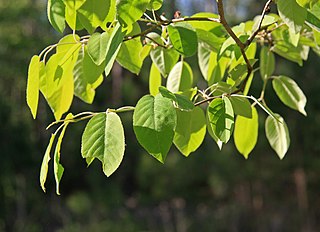
Amelanchier arborea, is native to eastern North America from the Gulf Coast north to Thunder Bay in Ontario and Lake St. John in Quebec, and west to Texas and Minnesota.

Sorbus cashmiriana, the Kashmir rowan, is a species of flowering plant in the family Rosaceae, native to the western Himalayas, including Kashmir.
Canadensis is a Neo-Latin term meaning of Canada, used in taxonomy to denote species indigenous to or strongly associated with Canada.

Amelanchier utahensis, the Utah serviceberry, is a shrub or small tree native to western North America. This serviceberry grows in varied habitats, from scrubby open slopes to woodlands and forests.
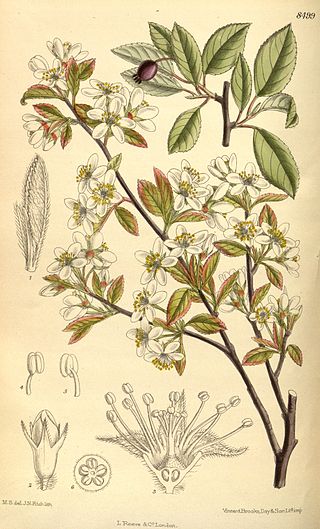
Amelanchier bartramiana is a species of serviceberry. Common names include mountain serviceberry, mountain shadbush, Bartram's serviceberry, mountain juneberry, Bartram juneberry, and the oblongfruit serviceberry.
Amelanchier humilis, commonly known as the low shadbush, is a North American species of serviceberry. It is native to central Canada and the northeastern and north-central United States.
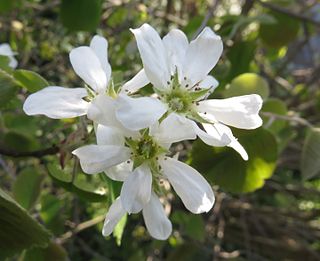
Amelanchier interior or Wiegand's shadbush is type of serviceberry shrub. It produces a sweet tasting edible fruit called a pome, which can be eaten raw or cooked. The fruit has a sweet flavor. This species is a deciduous tree. It grows on hillsides and banks of streams and reaches up to nine meters. The plant prefers light (sandy), medium (loamy) and heavy (clay) soils and can grow in heavy clay soil. It can grow in acid, neutral and alkaline soils, as well as shade or semi-shade. It requires moist soil.

Amelanchier laevis, the smooth shadbush, smooth serviceberry or Allegheny serviceberry, is a North American species of tree in the rose family Rosaceae, growing up to 9 metres (30 ft) tall. It is native to eastern Canada and the eastern United States, from Newfoundland west to Ontario, Minnesota, and Iowa, south as far as Georgia and Alabama.

Amelanchier × lamarckii, also called juneberry, serviceberry or shadbush, is a large deciduous flowering shrub or small tree in the family Rosaceae.
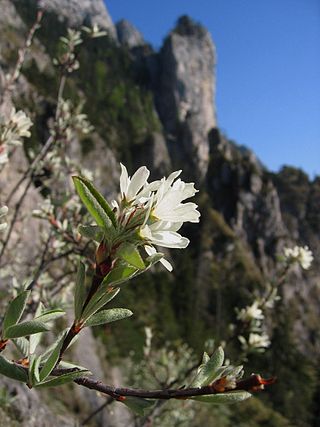
Amelanchier ovalis, commonly known as snowy mespilus or serviceberry, is a deciduous shrub in the family Rosaceae. Its pome fruits are edible and can be eaten raw or cooked. The species is native to central and southern Europe, as well as North Africa and the Middle East.

Amelanchier sanguinea, known as red-twigged shadbush or roundleaf serviceberry, is a shrub native to eastern and central North America. Its native range stretches from New Brunswick to Saskatchewan south as far as northern Georgia. It is most common in eastern Canada, the northeastern United States, and the Great Lakes region.
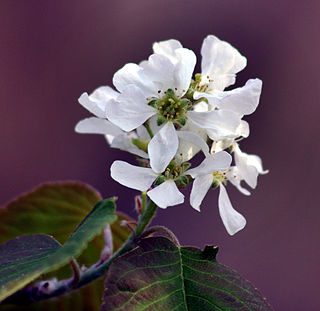
Amelanchier × spicata, also referred to as the low juneberry, thicket shadbush, dwarf serviceberry, or low serviceberry, is a hybrid of Amelanchier alnifolia × Amelanchier humilis. that has edible fruit, which are really pomes. They can be eaten raw or cooked. Amelanchier × spicata has clusters of small white flowers that bloom in spring.

The Maleae are the apple tribe in the rose family, Rosaceae. The group includes a number of plants bearing commercially important fruits, such as apples and pears, while others are cultivated as ornamentals. Older taxonomies separated some of this group as tribe Crataegeae, as the Cydonia group, or some genera were placed in family Quillajaceae.

Malinae is the name for the apple subtribe in the rose family, Rosaceae. This name is required by the International Code of Nomenclature for algae, fungi, and plants, which came into force in 2011 for any group at the subtribe rank that includes the genus Malus but not either of the genera Rosa or Amygdalus. The group includes a number of plants bearing commercially important fruits, such as apples and pears, while others are cultivated as ornamentals.

Rubus canadensis is a North American species of flowering plant in the rose family known by the common names smooth blackberry, Canadian blackberry, thornless blackberry and smooth highbush blackberry. It is native to central and eastern Canada and the eastern United States. It has also been sparingly recorded in Great Britain, in which it is often confused for the many other native blackberry species.

Amelanchier obovalis, the coastal serviceberry, coastal juneberry, or shadbush, is a species of flowering plant in the Rosaceae family. It is native to the Atlantic coastal plain of the United States, from New Jersey to Georgia, typically in pine barrens and other dry woodlands.


















